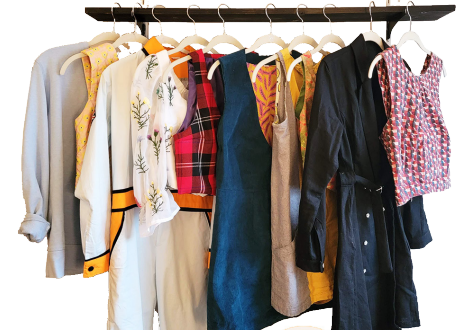WORKWEARandTEAR
Zephaniah Lynna Romualdo and Sophie Nguyentran, Taubman College of Architecture + Urban Planning
Collaborators: Sahr Qureishi, Taubman; Sabrina Ramsay, Taubman; Sydney Sinclair, Taubman; Caroline Stahl, Taubman; Valeria Velazaquez, Taubman
 Workplace architecture overtly favors the male body. This is observed in all non-domestic workplaces, from the construction site to high income offices. The worker is envisioned as a man in a full length suit at a corner office, or a man performing hard labor in rigid cotton work wear. When gender separations within the workplace began to disintegrate, women’s workwear manifested as iterations of the accepted male work uniform. It failed to recognize and accommodate the differing needs of the non-male body in space.
Workplace architecture overtly favors the male body. This is observed in all non-domestic workplaces, from the construction site to high income offices. The worker is envisioned as a man in a full length suit at a corner office, or a man performing hard labor in rigid cotton work wear. When gender separations within the workplace began to disintegrate, women’s workwear manifested as iterations of the accepted male work uniform. It failed to recognize and accommodate the differing needs of the non-male body in space.
This research project aims to investigate the shortcomings of architecture in meeting the needs of all workers, and to counter these failures through a range of modifiable workwear pieces that return bodily agency to the non-male worker. Garment performance will be evaluated in the physical workspace then also in the ubiquitous “workplace” constructed in Unreal Engine, using the projection VR/motion capture capabilities via the MIDEN in the Duderstadt Library.
We hope the project may facilitate a reshaping of work clothing’s slow-to-break mold. So-called workplace fashions have become, at worst, outdated, redundant, restrictive, and at their best inaccessible and unaffordable, if not bland. The team hopes to use the art of garment to not only celebrate but push and pull on the methodology of womenswear, therefore enhancing understanding of how designing dressing for specifically the workplace should not only dictated by the constraints of everyday function or commercial trends, but how garment, as an art and architecture for the woman’s body, may be generated through a multitude of work scenarios to produce a layered approach to how they may dress and express.
We’re thinking about architecture, textile and garment design, digital applications through set and production designing, cinematography, animation, photogrammetry and motion capture produced and exported through Unreal Engine. We’re interested in focusing on women who are in the service department, manual labor (within woodwork and metal work), and those within corporate office environments. The arts are expressed through film considerations, utilitarian clothing design, sound design, virtual reality, and final exhibition which is a mix between physical and digital immersion.
Our timeline goes from August to February of 2024. We’ll begin with research of digital and physical styling, workwear, textiles, materials, animation detailing, world-building, and interviews of candidates who have experience in these diverse workspaces. After, the design process of colleges and drafting to create tests for wearables, and scenes within Unreal Engine.
Production will begin in November which focuses on the production of wearables to the immersion of the world of Unreal Engine. Lastly, we will have an exhibition in February of our fabrication and performance of each wearable, scenes and process work within Unreal Engine and a zine of an explanation of motive and basic process.
Our work is divided into three realms of unreal, real, and publication/distribution. The first realm, that of the unreal, will simulate actual or likely workplace scenarios through character vignettes created in Unreal Engine to collect and synthesize speculative data on the needs of the wearer in different work environments. The second realm is that of material construction, assemblage, prototyping, and documentation to design and test the performance of adaptable, agency granting wearables that act as a counter to architecture that ignores the needs of the non-male body.
The final realm, publication and distribution, will not focus solely on representation of the research, but rather the details of publication, accessibility, and distribution of the work so that WORKWEARandTEAR may be built upon and accessed as a resource that serves as a guide for wearers to employ the wearables to gain agency of their bodily comfort in the workplace. The use of the resource will serve as a continuation of the research of WORKWEARandTEAR.
